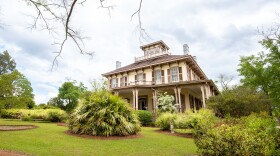In 1851, four men who had escaped from their enslaver in Baltimore County sparked a battle in the small Pennsylvania town of Christiana. An historic marker on York Road south of Hereford calls what happened a “riot.”
That mischaracterizes what was actually an act of resistance. There are plans to correct that historical record.
The men ran away from a farm owned by Edward Gorsuch and crossed into Pennsylvania. For a time they were protected by Pennsylvania state law, but then Congress passed the Fugitive Slave Act of 1850, which required runaway slaves to be returned.
So Gorsuch decided to round up a posse and go get his property.
He was told they were in Christiana.
“When Edward Gorsuch arrives in Christiana he meets a free Black community that’s ready for him,” said Andrew Diemer, a history professor at Towson University.
A group in Philadelphia that was trying to help fugitives escape slavery was tipped off about Gorsuch. In turn, they got word to a group of free Black people and fugitives in Christiana.
When Gorsuch arrived, there was an armed standoff.
Diemer said, “Someone in the house where these fugitive slaves are seeking refuge blows a horn as a signal to the community and people converge on this house in order to physically protect these fugitives from slavery.”
Gorsuch was killed and his son was wounded by gunfire. The fugitives escaped. It was front page news in the very first issue of the New York Times which called it a fugitive slave riot.
But that’s not the end of the story.
The federal government swooped in and arrested several dozen people and charged them with treason, including Ezekiel Thompson. He was Darlene Colon’s third great grandfather.

Colon said, “I’m sure he was one of those that when the alarm went out he was one of those that came, and as a result was arrested and taken to prison to be held for trial, charge of treason.”
But the first man to go on trial was acquitted by the jury in 15 minutes and the government dropped the charges against the others. Abolitionists cheered. But enslavers were troubled that there were no consequences for those involved. Christiana was a step towards the war that was less than 10 years away.
Colon said it’s a story that’s been all but lost to history.
“Somehow a shame was put on this story,” Colon said. “They called it a riot. I grew up here and never knew anything about this.”
Colon gives tours of a postage stamp sized one room museum in Christiana. It’s packed with photos and information related to what happened on September 11, 1851.
On this day Colon was telling the story to Deborah and Mike Tshudy and their daughter Beverly.
“This community came together,” Colon told the family. “There were different religions, different backgrounds. Different colors. But they all came together.”
“Every person is worthy of something good,” Mike Tschudy said.
On one wall is a question: Christiana: Riot or Resistance? Colon uses it as a teaching tool for students.

She said, “I look at that sign, riot or resistance. ‘Now when I tell you the story on what happened, what’s your thought?’”
Andrew Diemer at Towson University said the word ‘riot’ has been misused as a neutral term describing unavoidable racial conflict when in reality it was white people assaulting Black communities.
“Or in the case of Christiana it’s what we could more legitimately call a rebellion,” Diemer said.
The historical marker in Baltimore County, which was put up in 1964, calls it the Christiana riot. It marks the building, which still stands, where the Gorsuch posse met before heading to Pennsylvania. At that time it was a tavern.
Julie Schablitsky, chief archaeologist for the Maryland Department of Transportation (MDOT), said the sign needs to be changed.
“We need to expand the Christiana riot and put that in a proper perspective and remove some of the insensitive language,” Schablitsky said. “One particular phrase is ‘reclaim their slaves.’ So that’s definitely on our list to address.”
But it’s a long list. Schablitsky said there are dozens of historic markers in Maryland that are being reviewed. It will take years to get to them all.
MDOT took over the marker program from the Maryland Historical Trust several years ago. Since then, it’s been working through a backlog of requested new signs. Schablitsky said they are putting a hold on new markers so they can turn their attention to the old ones that need to be replaced.
Schablitsky said the markers are monuments “to these important people, places and events that happen in Maryland.”












